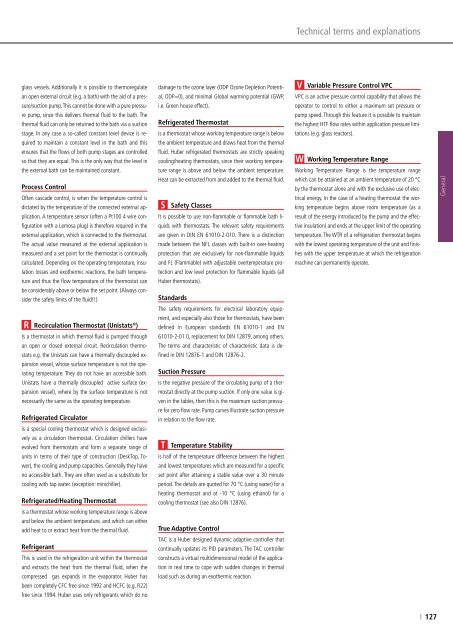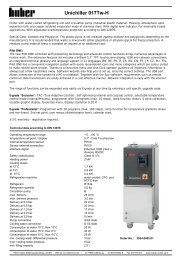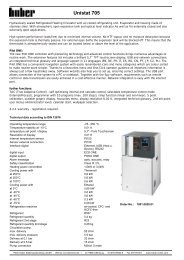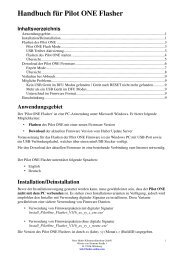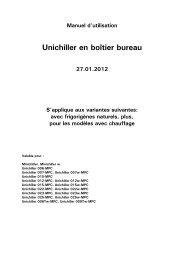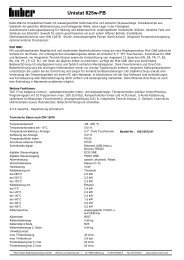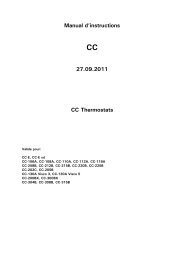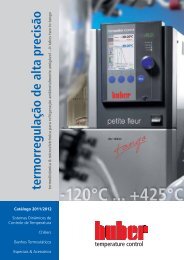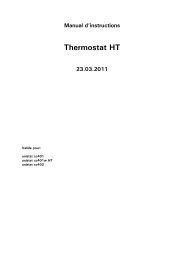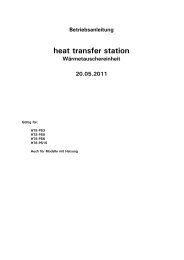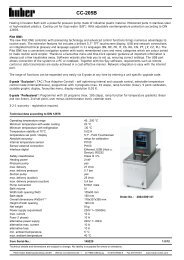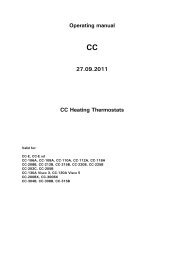Plug & Play - HUBER
Plug & Play - HUBER
Plug & Play - HUBER
Create successful ePaper yourself
Turn your PDF publications into a flip-book with our unique Google optimized e-Paper software.
glass vessels. Additionally it is possible to thermoregulate<br />
an open external circuit (e.g. a bath) with the aid of a pressure/suction<br />
pump. This cannot be done with a pure pressure<br />
pump, since this delivers thermal fluid to the bath. The<br />
thermal fluid can only be returned to the bath via a suction<br />
stage. In any case a so-called constant Ievel device is required<br />
to maintain a constant level in the bath and this<br />
ensures that the flows of both pump stages are controlled<br />
so that they are equal. This is the only way that the Ievel in<br />
the external bath can be maintained constant.<br />
Process Control<br />
Often cascade control, is when the temperature control is<br />
dictated by the temperature of the connected external application.<br />
A temperature sensor (often a Pt100 4 wire configuration<br />
with a Lemosa plug) is therefore required in the<br />
external application, which is connected to the thermostat.<br />
The actual value measured at the external application is<br />
measured and a set point for the thermostat is continually<br />
calculated. Depending on the operating temperature, insulation<br />
losses and exothermic reactions, the bath temperature<br />
and thus the flow temperature of the thermostat can<br />
be considerably above or below the set point. (Always consider<br />
the safety limits of the fluid!!)<br />
R Recirculation Thermostat (Unistats ® )<br />
Is a thermostat in which thermal fluid is pumped through<br />
an open or closed external circuit. Recirculation thermostats<br />
e.g. the Unistats can have a thermally discoupled expansion<br />
vessel, whose surface temperature is not the operating<br />
temperature. They do not have an accessible bath.<br />
Unistats have a thermally discoupled active surface (expansion<br />
vessel), where by the surface temperature is not<br />
necessarily the same as the operating temperature.<br />
Refrigerated Circulator<br />
is a special cooling thermostat which is designed exclusively<br />
as a circulation thermostat. Circulation chillers have<br />
evolved from thermostats and form a separate range of<br />
units in terms of their type of construction (DeskTop, Tower),<br />
the cooling and pump capacities. Generally they have<br />
no accessible bath. They are often used as a substitute for<br />
cooling with tap water. (exception: minichiller).<br />
Refrigerated/Heating Thermostat<br />
is a thermostat whose working temperature range is above<br />
and below the ambient temperature, and which can either<br />
add heat to or extract heat from the thermal fluid.<br />
Refrigerant<br />
This is used in the refrigeration unit within the thermostat<br />
and extracts the heat from the thermal fluid, when the<br />
compressed gas expands in the evaporator. Huber has<br />
been completely CFC free since 1992 and HCFC (e.g. R22)<br />
free since 1994. Huber uses only refrigerants which do no<br />
damage to the ozone layer (ODP Ozone Depletion Potential,<br />
ODP=0), and minimal Global warming potential (GWP,<br />
i.e. Green house effect).<br />
Refrigerated Thermostat<br />
is a thermostat whose working temperature range is below<br />
the ambient temperature and draws heat from the thermal<br />
fluid. Huber refrigerated thermostats are strictly speaking<br />
cooling/heating thermostats, since their working temperature<br />
range is above and below the ambient temperature.<br />
Heat can be extracted from and added to the thermal fluid.<br />
S Safety Classes<br />
lt is possible to use non-flammable or flammable bath liquids<br />
with thermostats. The relevant safety requirements<br />
are given in DIN EN 61010-2-010. There is a distinction<br />
made between the NFL classes with built-in over-heating<br />
protection that are exclusively for non-flammable liquids<br />
and FL (Flammable) with adjustable overtemperature protection<br />
and low level protection for flammable liquids (all<br />
Huber thermostats).<br />
Standards<br />
The safety requirements for electrical Iaboratory equipment,<br />
and especially also those for thermostats, have been<br />
defined in European standards EN 61010-1 and EN<br />
61010-2-01 0, replacement for DIN 12879, among others.<br />
The terms and characteristic of characteristic data is defined<br />
in DIN 12876-1 and DIN 12876-2.<br />
Suction Pressure<br />
is the negative pressure of the circulating pump of a thermostat<br />
directly at the pump suction. lf only one value is given<br />
in the tables, then this is the maximum suction pressure<br />
for zero flow rate. Pump curves illustrate suction pressure<br />
in relation to the flow rate.<br />
T Temperature Stability<br />
is half of the temperature difference between the highest<br />
and lowest temperatures which are measured for a specific<br />
set point after attaining a stable value over a 30 minute<br />
period. The details are quoted for 70 °C (using water) for a<br />
heating thermostat and at -10 °C (using ethanol) for a<br />
cooling thermostat (see also DIN 12876).<br />
True Adaptive Control<br />
TAC is a Huber designed dynamic adaptive controller that<br />
continually updates its PID parameters. The TAC controller<br />
constructs a virtual multidimensional model of the application<br />
in real time to cope with sudden changes in thermal<br />
load such as during an exothermic reaction.<br />
Technical terms and explanations<br />
V Variable Pressure Control VPC<br />
VPC is an active pressure control capability that allows the<br />
operator to control to either a maximum set pressure or<br />
pump speed. Through this feature it is possible to maintain<br />
the highest HTF flow rates within application pressure limitations<br />
(e.g. glass reactors).<br />
W Working Temperature Range<br />
Working Temperature Range is the temperature range<br />
which can be attained at an ambient temperature of 20 °C<br />
by the thermostat alone and with the exclusive use of electrical<br />
energy. In the case of a heating thermostat the working<br />
temperature begins above room temperature (as a<br />
result of the energy introduced by the pump and the effective<br />
insulation) and ends at the upper limit of the operating<br />
temperature. The WTR of a refrigeration thermostat begins<br />
with the lowest operating temperature of the unit and finishes<br />
with the upper temperature at which the refrigeration<br />
machine can permanently operate.<br />
127<br />
General


